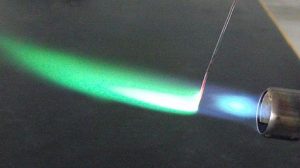Activity 3.9 NCERT Class 10 Science, Chapter 3 Metals and Non-metals
Brief procedure:
Activity 3.9 asks us to burn various metals and observe their flame.

Observation:
Not all metals burn easily, Copper and aluminium take time to burn.
Flame colour:
Sodium: Yellow
Magnesium: White
Aluminium: Silver white
Copper :blue flame
Solubility:
Highly reactive metals like sodium and potassium reacts with water and form soluble hydroxide. But most other metals are not so reactive. So they are not soluble in water.
Only some metal oxides that from metal hydroxide with water, are soluble in water. Else they are insoluble. Beryllium and magnesium are exceptions as they are slightly soluble in water.
Metal oxide + H2O(l) ———> Metal Hydroxide.
Explanation:
Metals are highly reactive elements. They react with oxygen readily to form metal oxides. Highly reactive metals like lithium, sodium, potassium, beryllium, magnesium react spontaneously. Other metals like Aluminum, copper take time to burn. It produces a specific flame colour. Many times flame colour is used to find the constituent of the substance.
Metal + O2(g) ———> Metal oxide(s)
Inference/conclusion:
Metals on the heating burn to produce its oxides. During this process, they produce characteristic flames.
Next: See how various metals react with water. Activity 3.10.
See also: The reaction of oxides of metal and non-metal with water, Activity 3.8.
Please do arrange the metals in decreasing order of their reactivity towards oxygen. Thanks.
Thank you
Most of the Metal oxides are NOT soluble in water …..plz do correct it
Reactivity series https://studdy.in/wp-content/uploads/2019/03/reactivity-series-of-metals-activity-3.12-science-1024×607.png
u havent arranged the metals in order of reactivity 🙁
very good explanation
Very helpful also but please write it in a proper format
Thank you so much
Very good Expalination……
Very much helpfull also but try to write in proper bookish format like:-
AIM:-
Materials required :-
Procedure:-
Observation:-
Conclusion:-
Do these improvements and this would be very much helpful for students that’s it !!!
It is very good but if you write it in a proper format like
Aim :
Materials Required :
PROCEDURE :
Observation :
Inference / Conclusion :